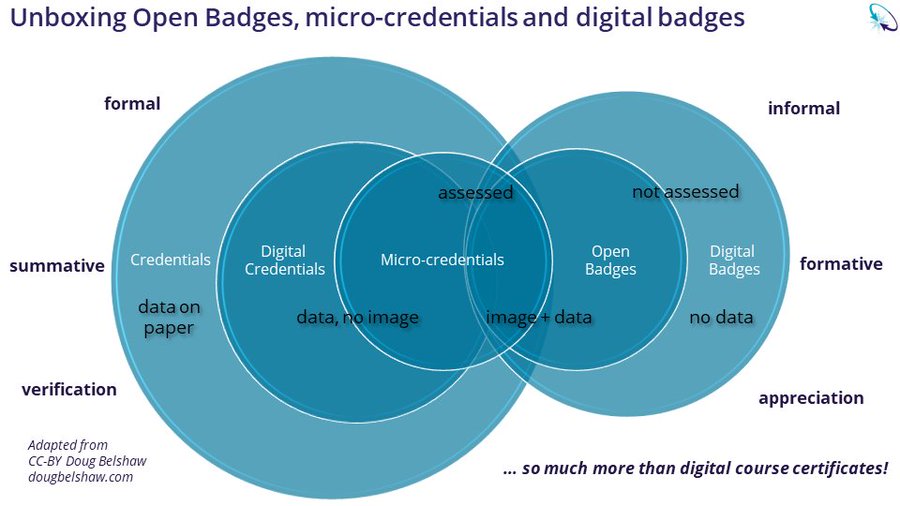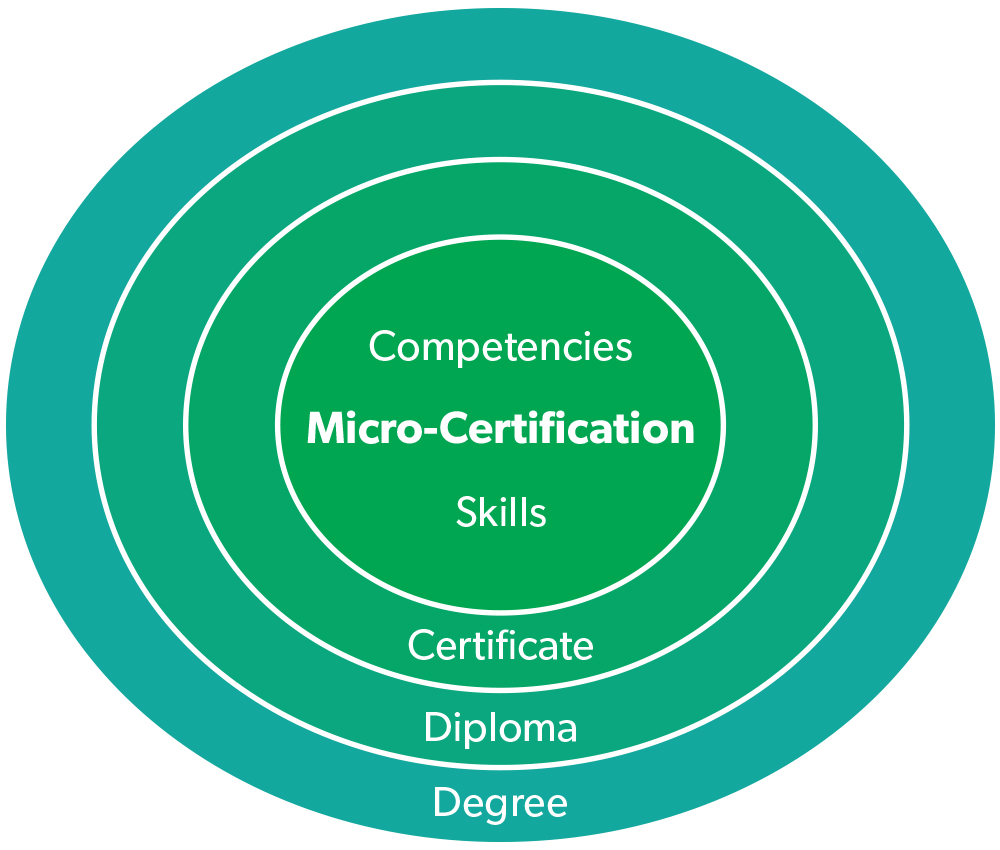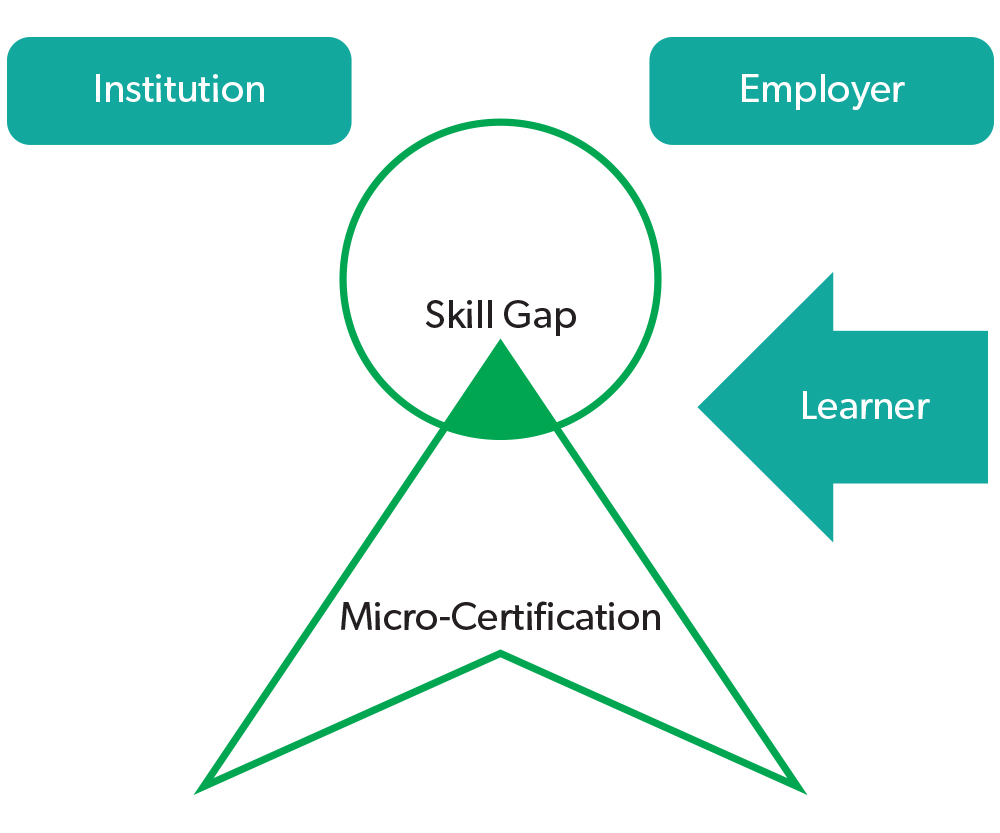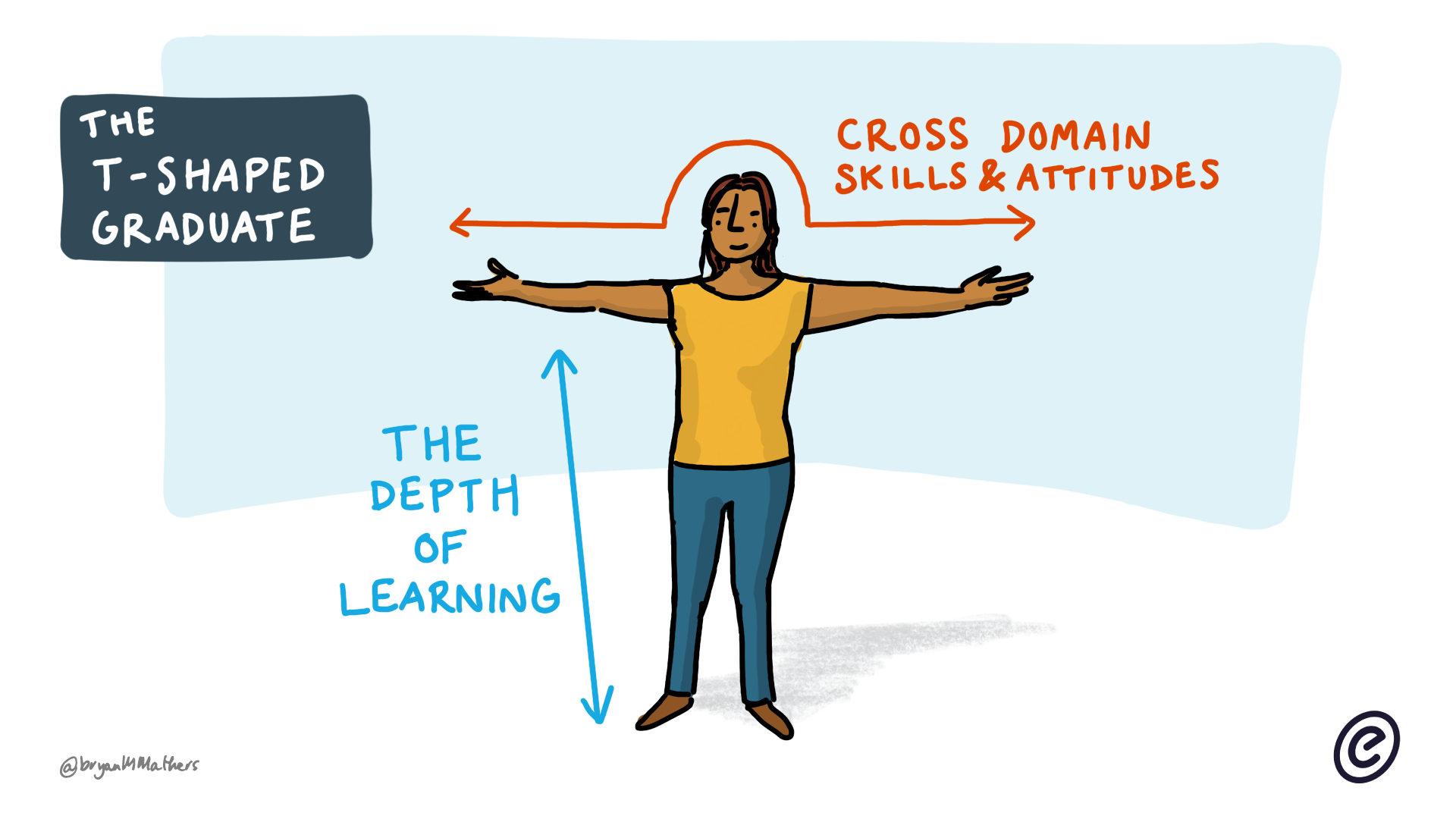Introduction to Micro-Credentials
| Site: | SCoPE - BCcampus Learning + Teaching |
| Group: | FLO MicroCourse: Micro-Credentials in the BC Context OER (March 2021) |
| Book: | Introduction to Micro-Credentials |
| Printed by: | Guest user |
| Date: | Saturday, 25 October 2025, 5:18 AM |
Description
Definition, History, Best Practices
Table of contents
- 1. Definition and Related Terms
- 2. History
- 3. What Do Moocs Have To Do With It?
- 4. Where Do Micro Credentials Fit?
- 5. Work Integrated Learning (WIL)
- 6. Context to Work
- 7. T Shaped Graduate
- 8. PLAR
- 9. Associated Technology
- 10. Micro-Credentials in Canada
- 11. Micro-certification in other parts of the world
- 12. Challenges of Micro-Credentials
- 13. Best Practices for Micro Credentials
- 14. References
1. Definition and Related Terms
Micro-credentials are an emerging trend in higher education that intersects with several areas of education technology, learning & teaching and open education. A micro-credential can be defined as a “single, shareable endorsement or attestation of a learner’s achievement of specific knowledge, skills or even competencies” (www.humber.ca)
One might hear about micro-certifications and wonder what is the difference between micro-credentials and micro-certifications. There is no difference - they are synomonous terms.
EcampusOntario uses the following definition from the Royal Melbourne Institute of Technology: "Microcertifications are used to certify an individual's achievements in specific skills and differ from traditional education credentials such as degrees and diplomas in that they are shorter, can be personalized and provide distinctive value and relevance in the changing world of work" (rmit.edu.au/creds/faq)
Another Australian author, Beverly Oliver, defines micro-credentials as "a certification of assessed learning that is additional, alternate. complementary to or a formal component of a formal qualification" (Oliver, 2019)
Mark Brown, from Dublin City University (home of the Micro-Credential Observatory) created this informative 10 minute video that "unboxes" microcredentials and provides context.
State University of New York (SUNY) denote 4 characteristics of micro-credentials:
- micro credentials verify, validate and attest that specific skills and or competencies have been achieved.
- micro credentials are endorsed by the issuing institution
- micro credentials have been developed through established faculy governance processes
- micro credentials are designed to be meaningful and high quality.
https://system.suny.edu/academic-affairs/microcredentials/definitions/
The term alternative credentials is also used to refer to micro-certifications. Kato et al (2020) in their OECD report defines alternative credentials as "credentials that are not recognized as standalone formal education qualifications by relevant national education authorities." They go on to classify three forms of alternative credentials: certificates, digital badges and micro-credentials.
Characteristics of alternative credentials:
- Could be delivered face to face, online or blended
- could take hours to months to complete
- could be validated by attendance, assignments and/or examinations
- focused on highly relevant skills need in the job market
(Kato et al, 2020)
Other terms related to micro-certifications are helpful to review:
Skills - "Ability to perform tasks due to one's knowledge, learning or practice" (www.workbc.ca)
Competencies - "Ability to perform specific tasks well and to adapt easily to the activities of a variety of jobs" (www.workbc.ca)
Characteristics - " Qualities that may influence both performance and the capacity to gain the knowledge and skills needed to perform work well" (www.workbc.ca)
Micro-credentials could be used to measure skills and competencies.
Another related term is competency based education which can be defined as "an outcome based approach to education that incorporates modes of instructional delivery and assessment efforts designed to evaluate mastery of learning by students through their demonstration of the knowledge, attitudes, values, skills, and behaviors required for the degree sought" (Gervais, 2016). Many learning management system allow for competencies, including Moodle.
2. History
It all started with a badge
The term digital badge was first introduced by Mozilla Foundation in 2011 as part of their Badges for Lifelong learning competition (Gibson et al, 2015). The open badges project with the MacArthur Foundation and started to “spark a transformation of how we recognize learning” (www.concentricsky.com). The mission of the Mozilla foundation is to “ensure the internet is a global public resource, open and accessible to all” (www.mozilla.org) – so open is one of their core values.
Mozilla were also the first to create a system of recording these digital representations of learning – the Mozilla backpack. This system integrated with many learning management systems and allowed people to reward badges to others based on non-learner recorded outcomes. Backpack was retired in August of 2019 and has now been moved to another open badge system called Badgr. All digital badges from Mozilla backpack have been transferred and retained. The open badge standard is now ensured by IMS Global, the organization that ensures SCORM standards. According to Mark Surmon (Mozilla) it was always the intention of Mozilla Open Badges to mature and make an impact for good (EcampusOntario, 2019).
This image from a recent presentation by Don Presant (an adaptation of an image by Doug Belshaw) shows the spectrum of credentials, micro-credentals and badges:
3. What Do Moocs Have To Do With It?
Since XMoocs exploded onto the scene in 2011 they have provided an alternative method for people to learn. An xMooc is designed to transmit information with little interaction between the teacher and learner whereas cMoocs focus on network building, interactivity and openness (Bates, 2014).
Out of the MOOC era came Coursera and Udacity – companies that provide access to Massive Open Online Courses and certification for a cost. Some must pay for access – either those that would like to receive credit or organizations that would like to provide training for their staff.
It is out of this environment that trademarked microcredential emerged. Udacity has trademarked Nano degree, Edevate has trademarked Micro Degree and EdX has trademarked MicroMasters (System.suny.edu) Coursera’s trademarked credential is “Mastertrack”. Other commercial badging systems such as Credly & Fidelis also arrived on the scene.
4. Where Do Micro Credentials Fit?

Focus
Micro credentials are really about specific skills and competencies that are in demand so the credential is smaller than a certificate - which is why the term "micro-certification" is often used.
Micro-credentials can be stacked to result in a bigger certification
Stakeholders
Key stakeholders for formal education:
- learners,
- employers,
- providers and
- policy makers
(Oliver, 2019). For micro-credentials the stakeholders are arguably the same.
Surfnet (2019) a Dutch organization lists the stakeholders for digital badges as:
- badge holder,
- badge issuer
- enquirer (assessor) (Surfnet, 2019)
The typical learner is well educated (already has a degree) average age is 36 and median salary is $50,000 US. (Kato et al, 2020). Their main motivation is acquire new skills and could include extrinsic, intrinsic and practical factors (ibid).
Micro-credentials complements prior education , experience & training (ibid)
The following image from the OECD (Kato et al) report shows how alternative credentials fit with other qualifications:
5. Work Integrated Learning (WIL)
WIL in the World of Micro-certifications
“Micro-credentialing offers a great opportunity to help our students prove their value to potential employers. We are excited to see how this exciting initiative can further work-integrated learning in BC.”
- Jennie Nilsson, President of ACE-WIL, October 2020
An unofficial scan of WIL-Micro-credential programs in BC has not produced any project in our province yet. However, at a recent Association of Cooperative Education and Work Integrated Learning townhalls, hosted by BCcampus and facilitated by ACE-WIL president, Jennie Nilsson, 77% of the attendees indicated that earning micro-credentials could be an incentive for students to participate in WIL activities, and 45% indicated that they have been in a discussion about micro-credentials related to Work Integrated Learning in the past six months. It seems the sector is ready to explore how micro-credentials could align with WIL.
Early in 2020, Anne Marie Fannon, the Director of the Professional Development Program at the University of Waterloo, did a keynote presentation on their participation in the eCampus Ontario project. Her topic "Skills, WIL, and the promise of micro-credentials" seems very appropriate as a starting point for our exploration into WIL & Micro-credentials. You can listen to her 30min presentation (from 1:21 to 1:52) here: Skills, WIL and the Promise of Micro-credentials
As we dig deeper into exploring micro-credentials in WIL, is important to consider the six challenges that were identified in the University of Waterloo WIL project:
1) The uniqueness of each student
2) Student self-assessment challenges
3) The uniqueness of each WIL setting
4) Identification of “career-readiness” benchmarks
5) WIL supervisor as assessor
6) Employers’ willingness to publicly endorse talents
The challenge around employers is about TRUST and ENDORSEMENT… Are employers willing to assess and endorse and make that public, and then consume one another’s endorsements? This would be an important challenge to address to secure the value of micro-credentials in WIL for all stakeholders.
Anne-Marie presented on the topic of WIL and Micro-credentialing at an ACE-WIL townhall on February 19th. You can listen to her sharing her micro-credential journey with us, and what she and her team at the University of Waterloo have learned over the past 18months about how to leverage micro-credentials to improve student experience as well as to recognize the competencies students display during their WIL experiences.
ACE-WIL townhall: Work-Integrated Learning and Micro-credentialing
You may find this infographic interesting - the results of a survey conducted by University of Waterloo to gain insights into the employer (124) and student (1016) perspectives : Survey Results
Another example of a seemingly successful WIL Digital Badging program can be found on the other side of Canada at the University of PEI. BCcampus recently spoke to Shannon Snow to gain some insights into their program, the challenges and success. You could listen to the 25minute interview here:
UPEI Digital WIL Interview with Shannon Snow
The topic of Micro-credentials is also on the radar of CEWIL (Co-operative Education and Work-Integrated Learning Canada), but no official announcement or publication has been released at the publishing of this course.
6. Context to Work
The following is an interesting Podcast from Peter Janzow, with Credly, a commercial provider of micro credentials, which captures the possible role of micro-credentials in the world of work:
Micro-credentials could capture the informal learning that takes place in the workplace or it could meet a specific need in the workplace. The main application of micro-credentials to the world of work is to fill a skills gap that is needed in a particular industry. The employer ideally works with a post secondary institution to meet the needs if the industry. This is shown in graphical form below:

7. T Shaped Graduate
The concept of "t- shaped graduates" is discussed frequently in relation to micro-credentials. It is best explained by a picture:

The depth of learning might be an advanced degree in engineering, for example, and the cross domain skills might be things like project management, analysis or inter personal skills.
This connects to micro-credentials because skills and attitudes could be obtained via a smaller micro-certification which is independent of the graduate's main knowledge area.
8. PLAR
PLAR stands for Prior Learning Assessment and Recognition and micro-credentials could serve as a good vehicle to recognizing prior learning, perhaps as a tool or within a portfolio.
PLAR tools include:
- Challenge Exams
- Demonstrations
- Structured Interviews
- Simulations
- Portfolios
PLAR recognizes that learning can be formal, informal, non formal or experiential. Micro-credentials can be formal or informal so there is a possible fit with PLAR
from https://capla.ca/
9. Associated Technology
The system that is required for micro-credentials tracks credentials earned is independent of learning management systems and provides a place where students can share their certifications with potential employers.
Blockchain is proving to be an applicable technology with its use of smart contracts and digital ledger system. An example of a Canadian company working in this area and serving the micro certification needs in Ontario is Learning Agents. Their micro-certification product is called CanCred and it has two parts: CanCred Factory (system for institutions to offer and record micro certifications) and CanCred Locker (system for learners to display micro-certifications).
In 2020 a new credential wallet called MyCreds.ca was introduced by Association of Registrars of the Universities & Colleges of Canada (ARUCC). The wallet can contain all of the learner's credentials - including microcredentials and badges.
Mozilla's original product for learners (Backpack) was handed off to Badgr and standards for their open badges system is now part of IMS Global.
10. Micro-Credentials in Canada
One of the first initiatives in Canada is EcampusOntario who are in the process of piloting micro-credentials in several member institutions. Saskatchewan is also investigating micro-credentials and Alberta University of the Arts has a micro-credential in four different business areas relating to the arts. An informal pan Canadian micro-credential group is just getting started and this will be helpful as we try to determine how micro-credentials fits into Canada's post secondary education landscape.
11. Micro-certification in other parts of the world
Our second day (Context) gives several international examples of micro-credentials - check it out now or later. Don't miss the Contact North webinar recording featuring New Zealand Qualification Authority.
12. Challenges of Micro-Credentials
Oliver (2019) points out the following challenges of micro-credentials for stakeholders:
- Learners - not fully engaged, unsure of the benefits of micro-credentials
- Employers - not aware of micro-credentials and what they are. Can they be trusted?
- Providers - struggling with funding models - how would they make money to at least break even.
13. Best Practices for Micro Credentials
- Think small - narrow down the competency. Not a course.
- Key employer / psi collaboration = success.
- Skill needs to be assessed. There needs to be rigor.
- Needs to be support to institutions
- Endorsement from institutions
[personal communication with Lena Patterson and Emma Gooch, EcampusOntario, May 21, 2020]
Characteristics of badges as a microcredential (Oliver, 2016b):
- Granular
- Stackable
- Evidentiary
- Personalized
- Machine readable
American Council on Education in SUNY's Whitepaper - Best Practices
- Transparency - be clear about what competencies are focused on and the relationship with other micro-credentials
- Modularity (stackable)
- Portability - the microcredential has value locally, nationally and/or betond.
- Relevant
- Validity - both predictive validity and concurrent validity
- Equity - all students should have an equal opportunity to succeed.
Quality is important as it is in any qualification. The following is a nice summary of how quality is measured in different countries (Kato et al, 2020):
14. References
Bates, Tony (2014, October 13) Comparing xMOOCs and cMOOCS: philosophy and practice. [blog post]. Online Learning and Distance Education Resources. Retrieved from https://www.tonybates.ca/2014/10/13/comparing-xmoocs-and-cmoocs-philosophy-and-practice/
EcampusOntario (2019, March 20th) Ontario Open Badge Forum 2019: Keynote: Badges as Alternative Credentials. [video]. YouTube. https://www.youtube.com/watch?v=X8qADDYiZjc
Gervais, J. (2016). The operational definition of competency‐based education. The Journal of Competency‐Based Education, 1(2), 98-106.
Gibson, D., Ostashewski, N., Flintoff, K., Grant, S., & Knight, E. (2015). Digital badges in education. Education and Information Technologies, 20(2), 403-410.
Janzow, P. (2014, Oct). Connecting learning to jobs through digital badges. The Catalyst, 42(2), 9-11.
Kato, S., V. Galán-Muros and T. Weko (2020), "The emergence of alternative credentials", OECD Education Working Papers, No. 216, OECD Publishing, Paris, https://doi.org/10.1787/b741f39e-en.
Oliver, B. (ed.). 2016b. Curate, Credential and Carry Forward Digital Learning Evidence. Final report of OLT Strategic Priority Project. Sydney, NSW, Australian Government Office for Learning and Teaching. http://hdl.voced.edu.au/10707/433268
Oliver, B. (2019) Making micro credentials work [White Paper}. Deakin University. http://dteach.deakin.edu.au/microcredentials/
State University of New York (2018) SUNY Micro-Credentialing Task Force Report and Recommendations. https://system.suny.edu/media/suny/content-assets/documents/academic-affairs/Micro-Credentialing-TaskForce--Report.pdf
Surfnet (2019) Open Badges and Micro-Credentials [White Paper]. Surf.net. https://www.surf.nl/en/white-paper-on-open-badges-and-micro-credentials